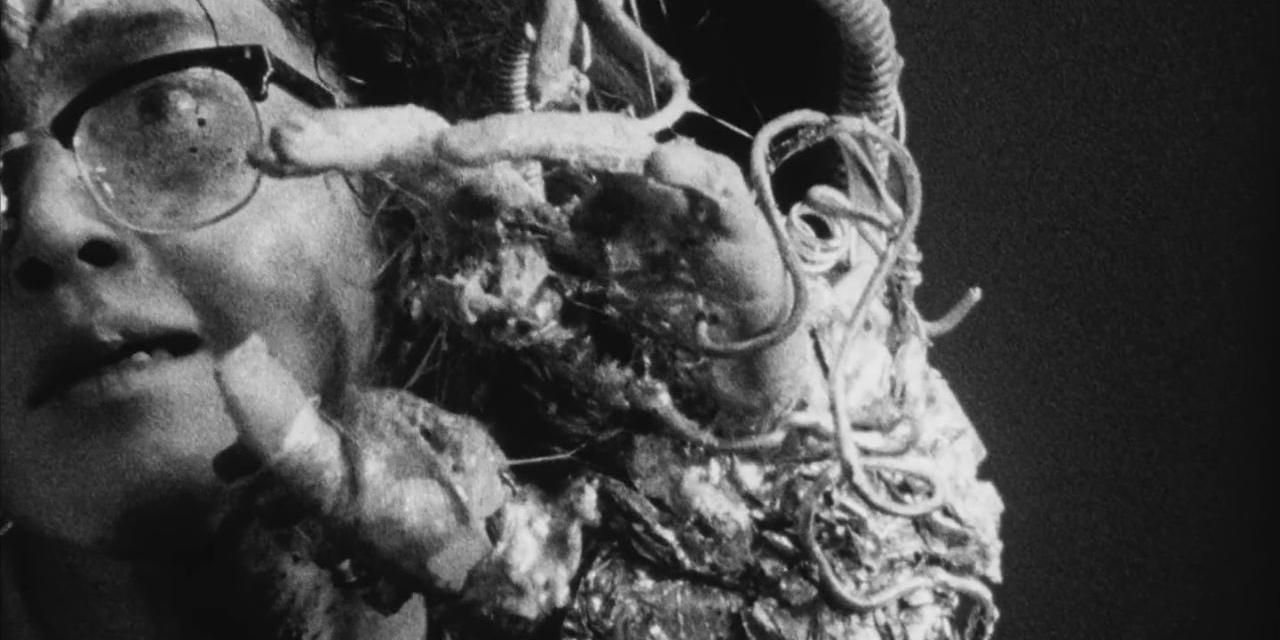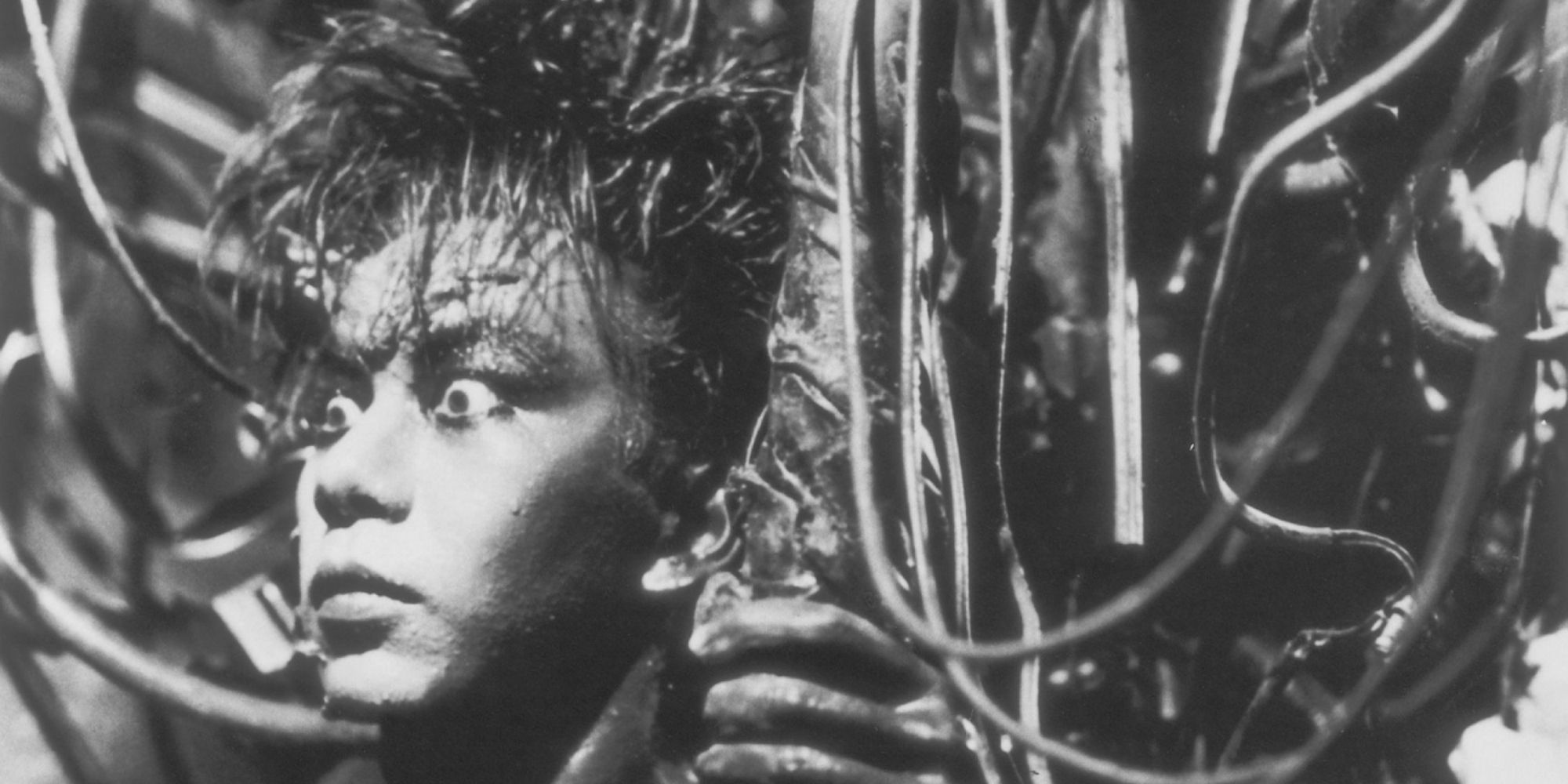It’s hard to define what exactly is so appealing about body horror but few have done it as effectively as Shinya Tsukamoto when, with barely any money at all, he directed one of its masterworks. If there’s one golden rule in the medium of Japanese animation that you can count on, it’s that every time you think it can’t get any crazier than this, it absolutely does. Fittingly, Tsukamoto’s Tetsuo: The Iron Man makes Videodrome look tame with regard to how much further it goes in terms of its depravity. Short in its length (a mere 67 minutes) and even smaller in terms of its budget, Tsukamoto uses black-and-white alongside handmade prosthetics to illustrate a man’s transformation into a metallic monster, mirroring the extent to which he’s delved deep into the dark recesses of his own fetishes. One-part depraved character study, one-part sexual nightmare and one-part superpowered cyborg anime, the film works on several levels, the most obvious one being to leave its audience with mouths agape after every scene.
There’s no doubt that Tetsuo: The Iron Man is one of the most disturbing movies that a cinephile could encounter. Just to say that the plot is hard to follow would be an atrocious understatement. It primarily follows two characters, a Metal Fetishist (played by Tsukamoto himself) obsessed with his attempts to modify his own body (in the most gruesome fashion imaginable) and a Salaryman (Tomorowo Taguchi) haunted by visions of industrial machinery after an as-of-yet unrevealed "incident." The Salaryman, who himself suffers from a metal spike protruding out of his cheek, slowly begins to metamorphose into a metallic monster himself. The result: two metal titans doing battle across Tokyo in one of the most inventive low-budget action scenes of all time.
‘Tetsuo: The Iron Man’ Uses Black-and-White to Establish a Horrifying Atmosphere
Though its third act may primarily be described as live-action Akira meets underground Iron Man, what happens prior sits solely within the realm of the disturbed. It’s impressive to be able to make it through the first 10 minutes alone without feeling horrifically squeamish, opening in the Metal Fetishist’s hideout and taking us through some of his rituals. The likes of which include rubbing metal against his teeth and inserting large metal rods into open wounds across his body. It’s just as disgusting as it sounds. What makes it even more horrifying (and practical with regard to its production costs) is Tsukamoto’s lo-fi black-and-white aesthetic, which pans over dusty, misshapen wires and analog tools of industry to give the viewer the impression that they’re looking at something rusting, filthy, and decrepit, confirmed when upon unwrapping a wound, the Metal Fetishist finds that it’s been infected by maggots. One would think that the black-and-white serves to tone down the gore but in actuality, the lack of realism makes it all the more nightmarishly sickening.
Sexual Fantasies Are a Major Theme in ‘Tetsuo: The Iron Man’
Before the film goes completely bonkers with its Iron Man-like final battle, Tetsuo is primarily concerned with this intersection between harmless hobbies and deviant obsessions, contrasting the Metal Fetishist with the Salaryman’s hidden sexual desires. What makes Tetsuo so scary isn’t necessarily the outstandingly grim set and sound design, but the idea that these fantasies lurk within us. As the Salaryman, at first showing no relation to the Metal Fetishist, starts to slowly adopt an increasingly metallic appearance, it’s only when his fantasies begin to manifest in a sexual context that the transformation is accelerated. In his dreams his wife sodomizes him with a metallic hose. Later on, his penis is transformed into a drill (yes, you read that right). Like the films of David Cronenberg however, the transformation is far from substance-less. His metallic transformation can rather be interpreted as a metaphor for his first exposure to a bizarre and unfamiliar fetish which he is disgusted to discover that he enjoys. The Salaryman’s girlfriend (Kei Fujiwara) meets her end when, after falsely believing that she’s killed him, she impales herself on his aforementioned drill, symbolizing how the embracement of his newly adopted sexual fantasy has led to her demise. Whereas previously one would be pardoned to think that there couldn’t be any intersection between an obsession with metal and sex, Tetsuo is ultimately a movie about hidden fetishes and how they have the dangerous potential to consume not only us, but those closest to us as well.
The Final Fight Is Like Nothing You’ve Ever Seen
After its revealed that the ‘incident’ that the Salaryman and his girlfriend previously mentioned is in fact running the Metal Fetishist over with their car (and attempting to cover it up), the Salaryman’s transformation into ‘the Iron Man’ becomes complete. The Metal Fetishist, himself transformed and seeking revenge, engages the Iron Man into a battle that wreaks havoc across all of Tokyo, the likes of which Tsukamoto shoots like a live-action anime, complete with crash zooms, stop-motion animation, miniatures, and one of the most nauseating use of slowly taped prosthetics ever put to screen. It’s a lesson for filmmakers of any level of experience, showcasing how much can be achieved in terms of large-scale action through hard work and barely any money at all. None of this would be possible had Tsukamoto not ingeniously masked these low-budget practical effects with his horrifying black-and-white cinematography, illustrating how embracing a film’s low-budget limitations can produce a genre-defying work of art.
At the end of the climactic battle, the Salaryman and the Metal Fetishist merge into one massive being of metal, uniting with one another through what appears to be the symbolic unification of their fetishes. The film ends with the new being vowing to turn the entire world into metal. Though the ending spells certain doom for humanity given their power, there is something rather endearing about these two conflicted figures, cast out from society for their garish desires, finding solace in one another even if it means turning against the rest of the world as a result. Is Tetsuo: The Iron Man secretly a romance? Absolutely not. However, given the theme of sex that runs throughout, it’s hard to divorce the union of these two enemies from romance altogether. If there is one thing that is certain, it’s that in spite of being a mere 67 minutes long, it is one of the most difficult and complicated movies you will ever have the pleasure of sitting through.



